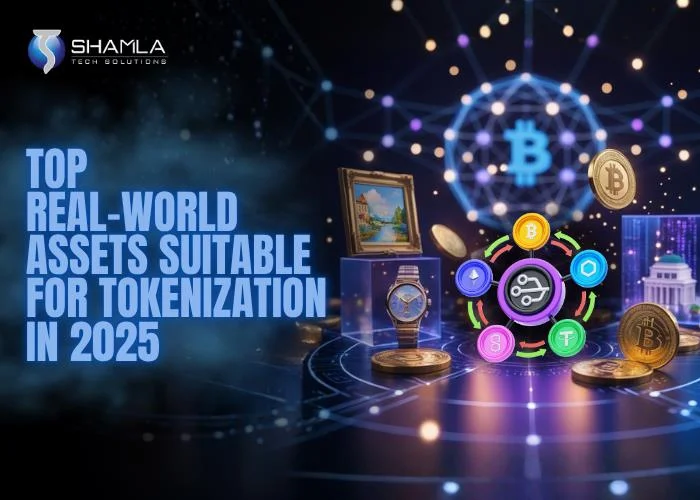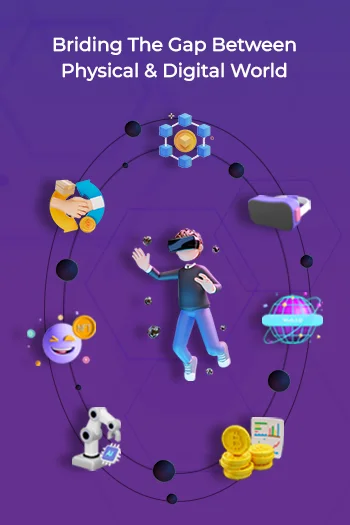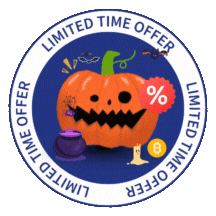Real World Asset Tokenization
Before looking at specific examples of asset tokenization, it’s important to understand the basic ideas behind this change.
What does it mean to tokenize real-world assets?
Real World Asset (RWA) Tokenization is the process of turning ownership rights in physical or traditional financial assets into digital tokens that may be used on blockchain networks. These tokens are digital representations of real assets that can be verified. They allow for fractional ownership, better liquidity, easier tracking, automated compliance, and access from anywhere in the world.
Tokenized assets have real-world value from things like buildings, commodities, bonds, art, or intellectual property. This is different from cryptocurrencies, which only exist digitally. Tokenized assets also benefit from blockchain infrastructure, which allows for 24/7 trading, fewer middlemen, instant settlement, programmable features through smart contracts, and unchangeable ownership records.
Why should you Tokenize assets in the real world?
The strong value proposition of RWA investment 2025 comes from a number of game-changing advantages:
Tokenization breaks up pricey assets into smaller, more inexpensive pieces. A $10 million commercial property can be broken up into 10,000 tokens worth $1,000 each. This makes assets that were only open to rich people or institutions available to everyone.
Improved liquidity: Real estate and private equity are examples of traditional illiquid assets that have few secondary markets and long transaction times. Tokenization makes markets more liquid by letting investors trade assets on digital exchanges 24 hours a day, 7 days a week. This greatly improves the efficiency of capital.
Global Market Access: Blockchain gets rid of geographic restrictions, linking investors from all over the world with a wide range of asset opportunities, no matter where they are. This opens up more sources of funds and investment options.
Lower Costs: By getting rid of middlemen, automating tasks with smart contracts, and making compliance easier, transaction costs go down by 30–80% compared to traditional techniques.
Blockchain offers unchangeable ownership records, a clear transaction history, a lower chance of fraud, and real-time asset tracking that increases confidence and lowers the number of disputes.
Programmable Features: Smart contracts let you set up automated dividend distribution, compliance enforcement, voting rights execution, and complicated investment structures without having to do anything by hand.
Knowing how much it costs to construct a best RWA tokens tokenization platform helps you understand how much money you’ll need to invest, which may be anywhere from $50,000 to $500,000 or more, depending on how complicated it is, how secure it needs to be, and what the rules are.
How does the tokenization process work?
1. Determining the type of financial instrument
Before they can think of anything blockchain-related, institutions need to figure out what kind of financial instrument they will be making with their tokenization initiative under financial services law. This is significant since the legal classification of the instrument will define all of the project’s future regulatory requirements and often whether or not it will work.
Collective investment programs and securities: When assets are pooled and split up, such when a piece of property is turned into 1,000 tokens, the result is frequently like a collective investment scheme (CIS). The Financial Services and Markets Act in the UK makes it very hard for a CIS to promote itself and ask for business. To get around these problems, most tokenization efforts structure their offerings as securities instead. This means they have to follow separate but equally complicated rules.
Buy-and-hold vs. secondary trading: As of July 2025, most tokenization initiatives work as buy-and-hold investments. This means that investors buy tokens directly from the issuer and can only sell them back to the same organization. Tokens can be freely sold between investors on the secondary market, but there are still a lot of regulatory restrictions that make this difficult.
UK and EU legislation says that securities that will be traded on a secondary market must be issued into a Central Securities Depository (CSD), which keeps the official record of who owns them. This need has led to regulatory sandboxes in the UK’s Digital Securities Sandbox and the EU DLT Pilot Regime to look at whether securities law needs to be changed for tokenized assets.
This regulatory difficulty is why most current tokenization efforts focus on simple buy-and-hold arrangements. In the meantime, more complicated secondary market trading features are still being worked on in regulatory sandboxes.
2. Choosing the right asset
RWAs that are easy to tokenize have explicit ownership rights, established ways to value them, and rules that make tokenization possible. It’s much better if those assets have steady cash flows and the chance to go up in value. So far, the most successful tokenization initiatives have used rather simple tools:
Debt instruments are corporate bonds or government securities that are set up for long-term investment.
Money market funds: UBS was the first to employ this method since money market funds are a simple way to test tokenization ideas.
Commodity backing: Tokens backed by gold, like PAX Gold, where each token stands for real gold in approved vaults.
3. Choosing the right blockchain
Choosing a blockchain is more complicated than most organizations first think:
Public vs. private networks: Public blockchains are open and have a solid infrastructure, but there are worries about who controls the validators and how private transactions are. Private networks provide you greater autonomy, but they might not operate with other networks and make you wonder if they are really decentralized.
Validator risk assessment: Institutions must analyze the possibility of unintentionally paying transaction fees to sanctioned entities functioning as validators on public blockchains. This assessment is easier with smaller, controlled networks, but they also increase risk.
Development infrastructure: Blockchains that have been around for a while, like Ethereum, have well-developed development tools, a lot of documentation, and well-known smart contract standards like ERC-3643 for tokens that need permission. Even said, other blockchains are being made just for tokenization in the field of TradFi.
In the end, the choice of blockchain will depend on a number of operational and risk variables, such as the project’s transaction volume, legal needs, and integration preferences.
4. Deploying smart contracts
Smart contracts can handle the complicated paperwork that makes owning assets the old-fashioned way slow and expensive. For instance, a tokenized real estate project can use a smart contract to automatically send rental money to thousands of tokenholders based on how much of the business they own. Smart contracts can handle interest payments and enforce maturity terms for tokenized bonds without the need for human action.
Smart contracts can also aid with regulatory compliance that would normally need teams of lawyers and compliance officers. Smart contracts can also make sure that only accredited investors buy certain security tokens, automatically freeze transactions to approved addresses, and make sure that trading only happens during allowed hours or with approved counterparties.
5. Integrating with infrastructure
Top real-world assets suitable for tokenization in 2025
- Real Estate: The Most Important Asset Class
Real estate tokenization Development is the most developed and active area of RWA tokenization in real estate investment. It includes commercial assets, residential structures, REITs (Real Estate investing Trusts), development projects, and agricultural property.
- Bonds and Treasury Instruments are Fixed Income Securities.
Tokenized bonds are one of the fastest-growing types of RWA crypto projects. Government bonds, corporate bonds, municipal bonds, and treasury bonds tokenization are all being turned into blockchain-based assets.
- Private Equity and Venture Capital
Private equity tokenization is a game-changing chance for an asset sector that has always been very illiquid, required high minimum investments, and was hard to get into.
- Goods: Gold, Silver, and Real Estate
Tokenized commodities connect actual assets with digital infrastructure. This makes it possible to invest in rare earth elements, precious metals, industrial metals, agricultural products, energy resources, and more.
- Collectibles and Art
Fine art, antique vehicles, rare wines, sports memorabilia, and luxury watches are all being turned into digital tokens, which is a new and quickly developing use case for tokenization.
- Royalties and Intellectual Property
Intellectual property, such as music royalties, film rights, patents, trademarks, and book publishing rights, is an example of inventive asset tokenization examples that makes money from creative and original labor.
- Project and Infrastructure Finance
Tokenization use cases is being used more and more by big infrastructure projects including renewable energy installations, transportation networks, telecommunications infrastructure, and water and utility systems to raise money and manage investments.
- Environmental Assets and Carbon Credits
Environmental assets including carbon credits, renewable energy certificates, water rights, and biodiversity offsets are new RWA investment prospects for 2025 that fit with trends toward sustainability.
- Supply Chain and Inventory Assets
Companies tokenize their inventory and supply chain assets, including as commodities in storage, shipments in transit, raw materials, and finished goods. This makes new ways to get money and makes operations run more smoothly.
- Insurance Products
Tokenization is being used more and more in insurance plans and risk pools for things like parametric insurance, catastrophe bond tokenization, reinsurance contracts, and peer-to-peer insurance models.
Choosing the Right Blockchain for Tokenization
Choosing the right blockchain platform is an important part of the tokenization process. The choice affects security, scalability, transaction costs, and how well everything works. Let’s look more closely at the things to think about and the choices available.
Not all blockchains are the same when it comes to tokenization. Here are three well-known platforms compared:
Ethereum is a pioneer in smart contract capabilities and has a large developer community and a wide range of decentralized applications (dApps). But it has had problems with scaling and hefty gas fees, which can make it hard for some projects to move forward.
Binance Smart Chain (BSC): BSC works with Ethereum’s environment, but transactions are faster and fees are lower. Its dual-chain structure makes it easy to move assets across chains, making it a cheap option for tokenization projects.
Hyperledger Fabric is a permissioned blockchain, which means that only certain people can use it. This makes it a good choice for businesses that need privacy and limited access. It has a modular architecture that lets you change it to fit the needs of your organization.
Conclusion
In 2025, there will be a wide range of real-world assets that can be tokenized. These include real estate, fixed income securities, private equity, commodities, art, intellectual property, infrastructure, environmental assets, supply chain finance, and insurance products. Each asset class has its own benefits, such as better liquidity, fractional ownership, global access, lower costs, and clear operations that change how investors buy and sell valuable assets.
Real World Asset (RWA) Tokenization has gone from being an experiment to being widely used. There are now billions of tokenized assets, institutional participation, regulatory frameworks that are getting stronger, and technology infrastructure that has been shown to sustain continued expansion. Cost of Building an RWA Tokenization Platform in 2025 will be a great year for investors, developers, and enterprises to get involved in this financial revolution. They can invest in tokenized real estate for stable income, tokenized bonds for guaranteed returns, or new types of investments like carbon credits.
Tokenise Your Physical Asset Today. Connect with us.



